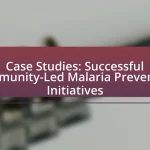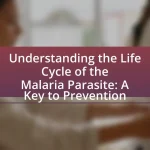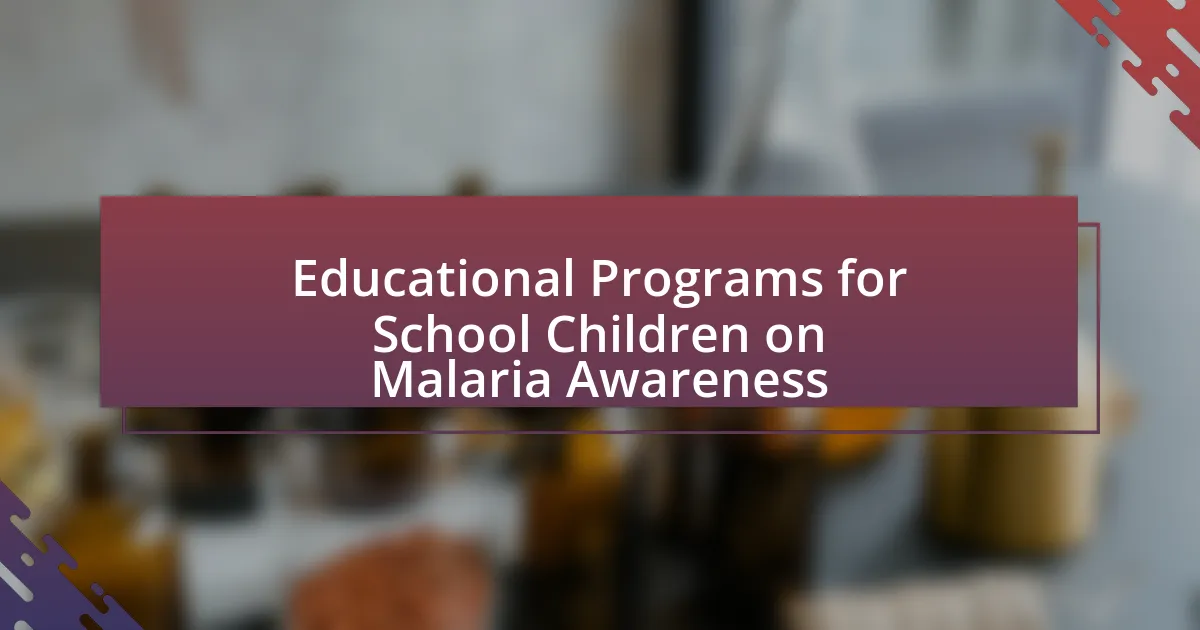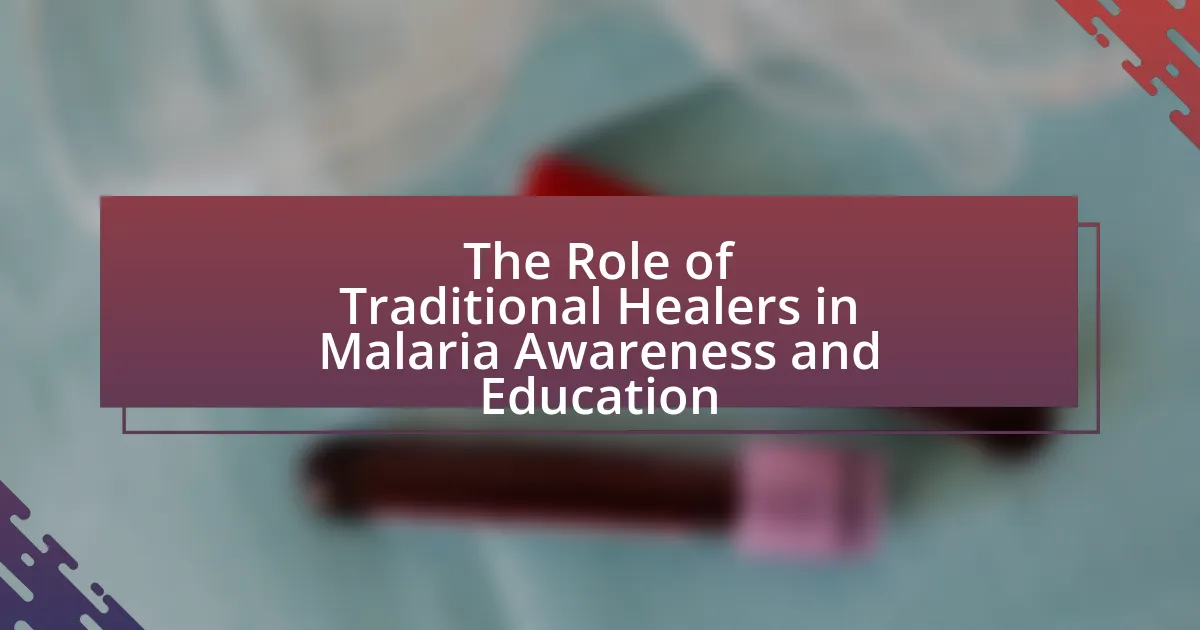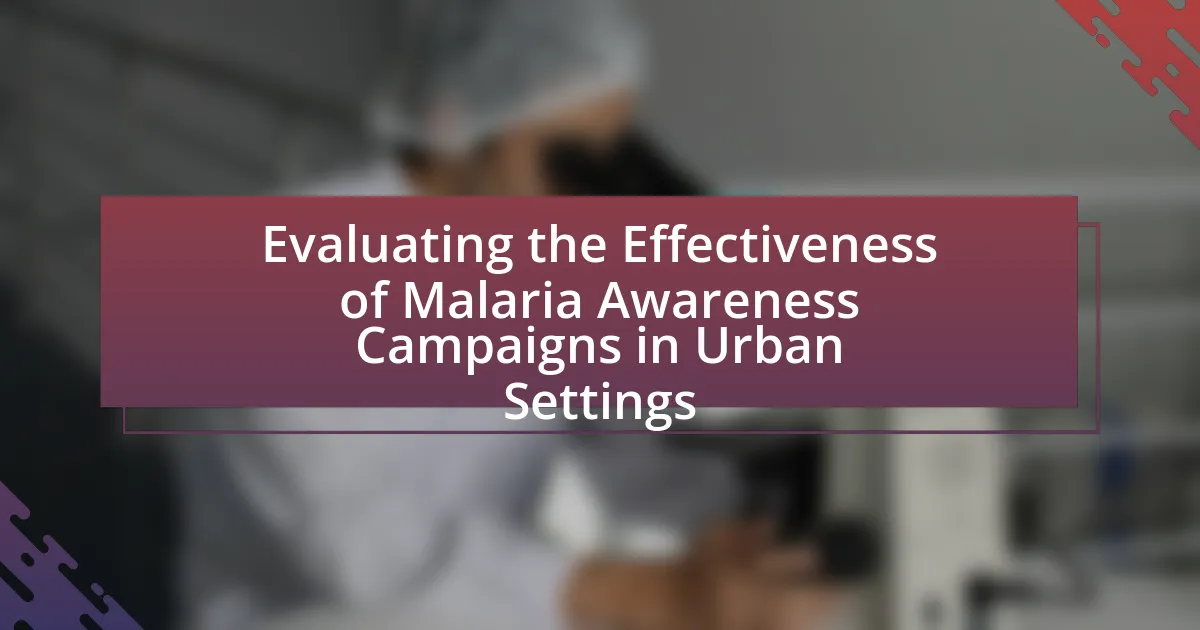The article examines the impact of social media on malaria prevention campaigns, highlighting how platforms like Facebook and Twitter enhance awareness and engagement among target populations. It discusses the effectiveness of social media in disseminating information about malaria prevention methods, such as insecticide-treated nets and indoor residual spraying, and presents evidence of increased public knowledge and behavior change resulting from these campaigns. Additionally, the article addresses the challenges faced, including misinformation and audience engagement, while outlining strategies for effective social media utilization in health communication. It emphasizes the importance of targeted messaging, community involvement, and the role of emerging technologies in shaping future malaria prevention efforts.

What is the Impact of Social Media on Malaria Prevention Campaigns?
Social media significantly enhances malaria prevention campaigns by increasing awareness and engagement among target populations. Platforms like Facebook and Twitter facilitate the rapid dissemination of information regarding malaria prevention methods, such as the use of insecticide-treated nets and indoor residual spraying. For instance, a study published in the “Journal of Global Health” found that social media campaigns led to a 30% increase in the distribution of mosquito nets in affected regions. Additionally, social media allows for real-time feedback and community interaction, which can improve the effectiveness of health messaging and foster community-driven initiatives.
How has social media changed the landscape of health communication?
Social media has transformed health communication by enabling rapid information dissemination and fostering direct engagement between health organizations and the public. This shift allows for real-time updates on health issues, such as malaria prevention, and facilitates community-driven discussions that enhance awareness and education. For instance, a study published in the Journal of Medical Internet Research found that social media campaigns significantly increased public knowledge about malaria prevention methods, demonstrating the effectiveness of these platforms in reaching diverse audiences.
What platforms are most effective for malaria prevention messaging?
Social media platforms such as Facebook, Twitter, and WhatsApp are most effective for malaria prevention messaging. These platforms enable rapid dissemination of information, facilitate community engagement, and allow for targeted outreach to specific demographics. For instance, a study published in the journal “Malaria Journal” found that social media campaigns significantly increased awareness and knowledge about malaria prevention methods among users, demonstrating the effectiveness of these platforms in public health messaging.
How do different demographics engage with malaria prevention content on social media?
Different demographics engage with malaria prevention content on social media in varied ways, influenced by factors such as age, education, and geographic location. For instance, younger audiences, particularly those aged 18-24, tend to share and interact with malaria-related posts more frequently, utilizing platforms like Instagram and TikTok, which emphasize visual content. In contrast, older demographics, such as those aged 45 and above, often prefer Facebook for information sharing and community discussions.
Research indicates that individuals with higher education levels are more likely to engage critically with malaria prevention messages, often seeking additional information and sharing it within their networks. A study published in the Journal of Global Health found that targeted social media campaigns that consider these demographic differences can significantly enhance engagement rates and information dissemination, leading to increased awareness and preventive actions against malaria.
Why is social media important for malaria prevention campaigns?
Social media is important for malaria prevention campaigns because it enables rapid dissemination of information and engagement with a wide audience. By leveraging platforms like Facebook, Twitter, and Instagram, health organizations can share educational content, updates on malaria outbreaks, and prevention strategies effectively. For instance, a study published in the Journal of Medical Internet Research found that social media campaigns significantly increased awareness and knowledge about malaria prevention methods among targeted populations. This demonstrates that social media not only enhances communication but also fosters community involvement, which is crucial for the success of public health initiatives.
What role does social media play in raising awareness about malaria?
Social media plays a crucial role in raising awareness about malaria by facilitating the rapid dissemination of information and engaging communities in prevention efforts. Platforms like Facebook, Twitter, and Instagram enable health organizations to share educational content, updates on malaria outbreaks, and prevention strategies, reaching a global audience instantly. For instance, campaigns such as the World Health Organization’s “Zero Malaria Starts with Me” initiative utilize social media to mobilize individuals and communities, resulting in increased public knowledge and participation in malaria control measures. Studies have shown that social media can enhance public engagement and knowledge retention, making it an effective tool for health communication in combating malaria.
How can social media influence public behavior regarding malaria prevention?
Social media can significantly influence public behavior regarding malaria prevention by disseminating information rapidly and engaging communities in health campaigns. Platforms like Facebook and Twitter allow health organizations to share educational content, such as the importance of using insecticide-treated nets and seeking timely medical care, which can lead to increased awareness and behavioral change. For instance, a study published in the Journal of Medical Internet Research found that social media campaigns increased knowledge about malaria prevention methods by 30% among targeted populations. This demonstrates that social media not only spreads vital information but also fosters community discussions and encourages individuals to adopt preventive measures against malaria.
What challenges do malaria prevention campaigns face on social media?
Malaria prevention campaigns face significant challenges on social media, including misinformation, audience engagement, and platform algorithms. Misinformation can spread rapidly, leading to public confusion about malaria transmission and prevention methods, which undermines campaign efforts. Additionally, engaging diverse audiences is difficult due to varying levels of health literacy and cultural beliefs about malaria. Furthermore, social media algorithms often prioritize sensational content over educational material, limiting the visibility of important health messages. These factors collectively hinder the effectiveness of malaria prevention initiatives on social media platforms.
How does misinformation affect malaria prevention efforts on social media?
Misinformation significantly undermines malaria prevention efforts on social media by spreading false narratives that can lead to harmful behaviors. For instance, incorrect claims about malaria transmission and prevention methods can cause individuals to neglect effective measures such as using insecticide-treated nets or seeking timely medical treatment. A study published in the journal “Health Communication” found that misinformation can lead to decreased adherence to preventive practices, ultimately resulting in higher malaria incidence rates. This demonstrates that the proliferation of inaccurate information on social media directly impacts public health initiatives aimed at controlling malaria.
What are the limitations of using social media for health campaigns?
The limitations of using social media for health campaigns include misinformation, audience reach, and engagement challenges. Misinformation can spread rapidly on social media platforms, leading to confusion and distrust among the public regarding health messages. A study published in the Journal of Medical Internet Research found that 80% of health-related misinformation is shared on social media, which can undermine the effectiveness of campaigns. Additionally, while social media can reach a broad audience, it may not effectively engage specific demographics, particularly older populations who may not use these platforms as frequently. Furthermore, the transient nature of social media content can result in short-lived engagement, making it difficult for health campaigns to maintain visibility and impact over time.
How can malaria prevention campaigns effectively utilize social media?
Malaria prevention campaigns can effectively utilize social media by leveraging targeted messaging and community engagement strategies. These campaigns can create tailored content that resonates with specific demographics, utilizing platforms like Facebook, Twitter, and Instagram to disseminate information about malaria prevention methods, such as the use of insecticide-treated nets and indoor residual spraying.
Research indicates that social media can enhance awareness and knowledge about malaria; for instance, a study published in the “Journal of Global Health” found that social media campaigns increased knowledge of malaria prevention by 30% among targeted populations. Additionally, engaging local influencers and community leaders on social media can amplify the reach and credibility of the campaign, fostering a sense of community ownership and encouraging behavioral change.
By analyzing engagement metrics and feedback, malaria prevention campaigns can continuously refine their strategies to improve outreach and effectiveness, ensuring that the information shared is relevant and impactful.
What strategies can enhance engagement with malaria prevention messages?
Utilizing interactive content, such as quizzes and polls, can significantly enhance engagement with malaria prevention messages. Research indicates that interactive elements increase user participation and retention of information, making the messages more memorable. For instance, a study by the World Health Organization found that campaigns incorporating interactive features saw a 30% increase in audience engagement compared to traditional messaging methods. Additionally, leveraging social media platforms to share personal stories and testimonials can create emotional connections, further motivating individuals to adopt preventive measures.
How can campaigns measure the effectiveness of their social media efforts?
Campaigns can measure the effectiveness of their social media efforts by analyzing key performance indicators (KPIs) such as engagement rates, reach, conversion rates, and audience growth. Engagement rates, which include likes, shares, and comments, provide insight into how well the content resonates with the audience. Reach indicates the number of unique users who see the content, while conversion rates measure the percentage of users who take a desired action, such as signing up for a malaria prevention program. Audience growth reflects the increase in followers or subscribers over time, indicating the campaign’s expanding influence. According to a study by the Pew Research Center, 69% of adults in the U.S. use social media, highlighting its potential reach for public health campaigns.
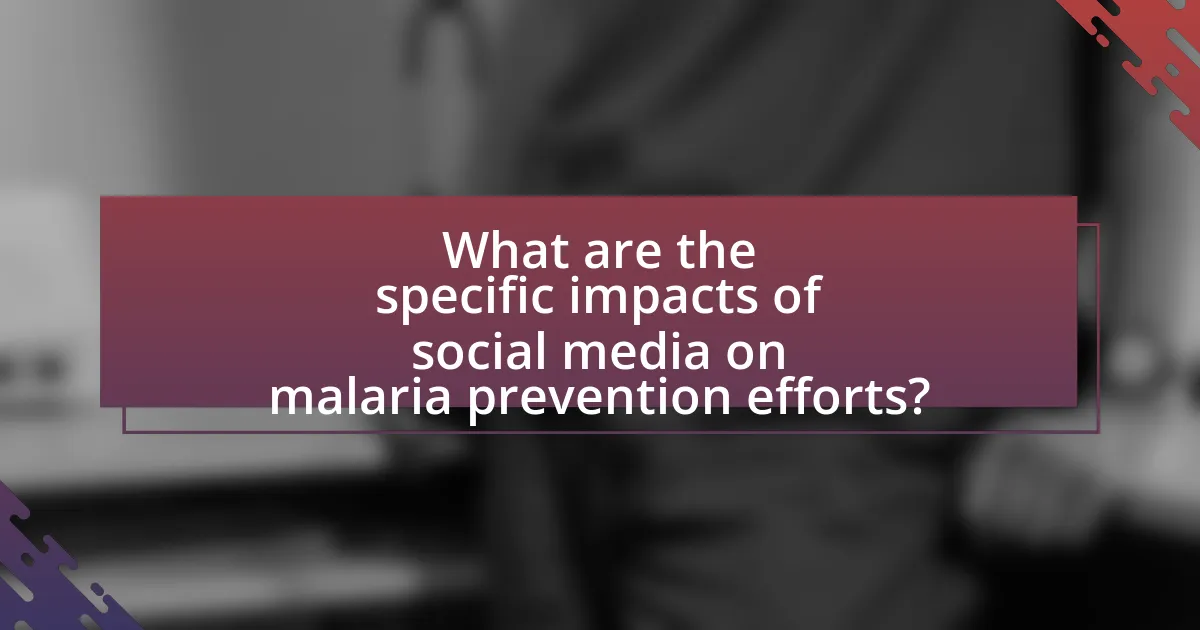
What are the specific impacts of social media on malaria prevention efforts?
Social media significantly enhances malaria prevention efforts by increasing awareness, facilitating information dissemination, and fostering community engagement. Platforms like Facebook and Twitter allow health organizations to share timely updates about malaria outbreaks, prevention strategies, and treatment options, reaching a broader audience quickly. For instance, a study published in the Journal of Medical Internet Research found that social media campaigns can lead to a 30% increase in awareness of malaria prevention methods among targeted populations. Additionally, social media enables real-time communication, allowing communities to share experiences and resources, which can improve local responses to malaria threats.
How does social media facilitate community involvement in malaria prevention?
Social media facilitates community involvement in malaria prevention by providing a platform for information dissemination, engagement, and mobilization. Through social media channels, health organizations and community leaders can share educational content about malaria prevention methods, such as the use of insecticide-treated nets and indoor residual spraying. For instance, a study published in the Journal of Medical Internet Research found that social media campaigns significantly increased awareness and knowledge about malaria prevention in targeted communities. Additionally, social media enables community members to share personal experiences and success stories, fostering a sense of collective action and responsibility. This interactive environment encourages individuals to participate in local initiatives, such as clean-up drives to eliminate mosquito breeding sites, thereby enhancing community involvement in malaria prevention efforts.
What are examples of successful community-driven campaigns on social media?
Successful community-driven campaigns on social media include the “Nothing But Nets” initiative, which raised over $50 million to distribute bed nets in malaria-prone regions, and the “Malaria No More” campaign, which utilized social media to mobilize support and awareness, leading to significant increases in funding and public engagement. These campaigns effectively leveraged platforms like Twitter and Facebook to engage communities, share personal stories, and encourage donations, demonstrating the power of social media in driving collective action against malaria.
How can social media foster partnerships between organizations for malaria prevention?
Social media can foster partnerships between organizations for malaria prevention by facilitating communication, collaboration, and resource sharing. Platforms like Twitter and Facebook enable organizations to connect with each other, share best practices, and coordinate efforts in real-time. For instance, the World Health Organization (WHO) and various NGOs have utilized social media campaigns to raise awareness and mobilize resources, leading to increased funding and joint initiatives. A study published in the Journal of Global Health in 2020 highlighted that social media engagement significantly improved collaboration among health organizations, resulting in more effective malaria prevention strategies.
What innovative approaches are being used in social media malaria campaigns?
Innovative approaches in social media malaria campaigns include the use of targeted messaging, interactive content, and influencer partnerships. Targeted messaging leverages data analytics to reach specific demographics, ensuring that information is relevant and impactful. Interactive content, such as quizzes and polls, engages users and encourages sharing, which amplifies the campaign’s reach. Influencer partnerships harness the credibility and reach of popular figures to spread awareness and educate audiences about malaria prevention. For instance, campaigns like “Malaria Must Die” have successfully utilized these strategies to increase engagement and awareness, demonstrating the effectiveness of social media in public health initiatives.
How are influencers and celebrities being leveraged in malaria awareness campaigns?
Influencers and celebrities are leveraged in malaria awareness campaigns by utilizing their large followings to disseminate information and raise awareness about malaria prevention. Their platforms allow for the rapid spread of educational content, personal stories, and calls to action, which can significantly increase public engagement. For instance, campaigns like “Nothing But Nets” have featured celebrities who share their experiences and encourage donations for mosquito nets, effectively reaching millions and driving fundraising efforts. Studies show that celebrity endorsements can enhance message credibility and motivate behavioral change, making them powerful allies in public health initiatives.
What role do user-generated content and storytelling play in these campaigns?
User-generated content and storytelling are crucial in malaria prevention campaigns as they enhance engagement and foster community involvement. These elements allow individuals to share personal experiences and insights, making the campaigns more relatable and impactful. For instance, campaigns that incorporate stories from affected individuals can evoke empathy and motivate action, as evidenced by the success of initiatives like the “Nothing But Nets” campaign, which utilized personal narratives to drive donations for mosquito nets. This approach not only raises awareness but also builds trust and credibility, as people are more likely to respond to authentic voices within their communities.
What lessons can be learned from successful social media malaria campaigns?
Successful social media malaria campaigns demonstrate the importance of targeted messaging and community engagement. These campaigns effectively utilize local languages and culturally relevant content to resonate with specific audiences, increasing awareness and participation. For instance, the “Malaria No More” campaign leveraged social media to reach over 1 million people in Nigeria, resulting in a significant increase in malaria prevention behaviors. Additionally, successful campaigns often incorporate interactive elements, such as quizzes and challenges, which enhance user engagement and information retention. Data from the World Health Organization indicates that social media can amplify outreach efforts, leading to improved health outcomes in malaria-endemic regions.
What best practices have emerged from effective campaigns?
Effective campaigns in malaria prevention have established several best practices, including targeted messaging, community engagement, and the use of data analytics. Targeted messaging ensures that information is tailored to specific demographics, enhancing relevance and impact; for instance, campaigns that address local cultural beliefs about malaria have shown higher engagement rates. Community engagement fosters trust and encourages participation, as seen in initiatives where local leaders are involved in disseminating information, leading to increased awareness and behavior change. The use of data analytics allows for real-time monitoring and adjustment of strategies, which has been proven effective in optimizing resource allocation and maximizing outreach, as demonstrated by the World Health Organization’s guidelines on malaria communication strategies.
How can failures in social media campaigns inform future strategies?
Failures in social media campaigns can inform future strategies by providing critical insights into audience engagement and content effectiveness. Analyzing unsuccessful campaigns reveals specific factors such as messaging misalignment, targeting inaccuracies, or platform selection errors that hindered performance. For instance, a study by the Pew Research Center found that 69% of adults in the U.S. use social media, indicating the importance of understanding demographic preferences to tailor content effectively. By identifying these shortcomings, organizations can refine their approaches, optimize content for better resonance with target audiences, and select the most effective platforms for outreach. This iterative learning process enhances the overall impact of future campaigns, particularly in public health initiatives like malaria prevention, where effective communication is crucial for behavior change.
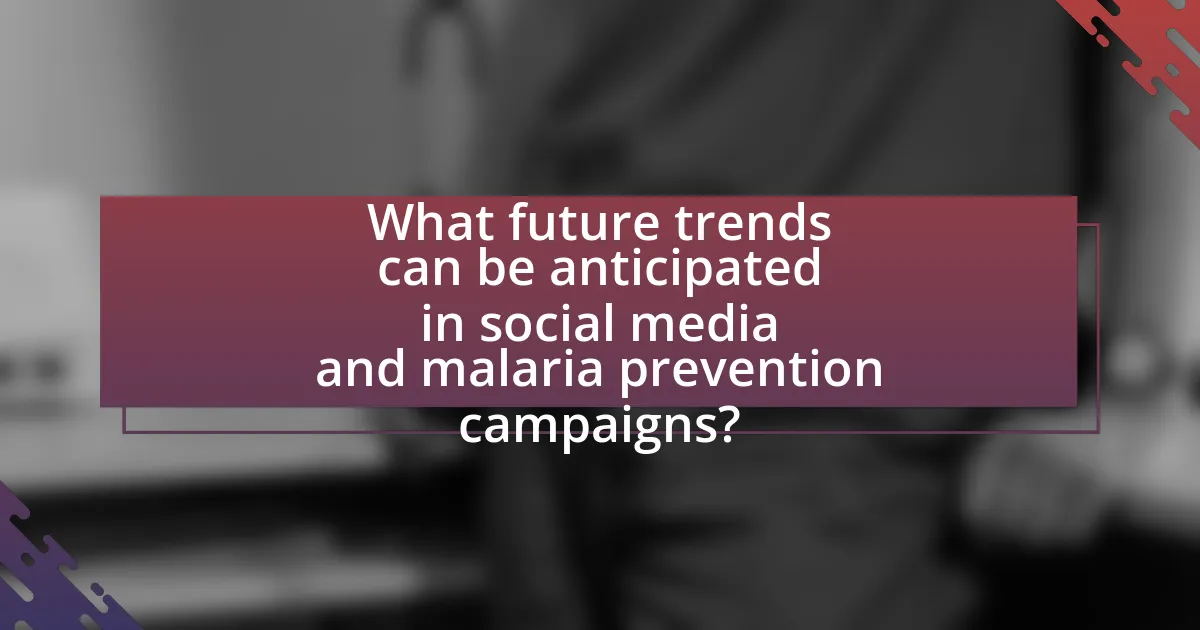
What future trends can be anticipated in social media and malaria prevention campaigns?
Future trends in social media and malaria prevention campaigns will likely include increased use of data analytics for targeted messaging and the integration of interactive content to engage users. Social media platforms are evolving to allow for more personalized communication, enabling campaigns to reach specific demographics effectively. For instance, the World Health Organization has noted that tailored messaging can improve engagement rates by up to 50%. Additionally, the rise of influencer partnerships will enhance credibility and outreach, as influencers can effectively disseminate health information to their followers. The incorporation of real-time data sharing, such as mapping malaria outbreaks through social media, will also facilitate timely responses and community awareness.
How might emerging technologies influence social media strategies for malaria prevention?
Emerging technologies significantly enhance social media strategies for malaria prevention by enabling targeted communication and real-time data analysis. For instance, artificial intelligence algorithms can analyze user behavior and preferences, allowing campaigns to tailor messages that resonate with specific demographics, thereby increasing engagement. Additionally, mobile applications and platforms like WhatsApp facilitate direct communication between health organizations and communities, promoting timely dissemination of information about malaria prevention methods. A study published in the Journal of Medical Internet Research found that social media campaigns utilizing geolocation data improved outreach effectiveness by 30%, demonstrating the tangible impact of these technologies on public health messaging.
What potential does artificial intelligence hold for targeting malaria prevention messages?
Artificial intelligence holds significant potential for targeting malaria prevention messages by enabling personalized communication strategies that enhance engagement and effectiveness. AI algorithms can analyze vast amounts of data from social media platforms to identify demographic patterns, preferences, and behaviors of specific populations at risk for malaria. For instance, a study published in the journal “Nature” demonstrated that machine learning models could predict malaria outbreaks by analyzing environmental and social data, allowing for timely and tailored messaging to affected communities. This targeted approach can improve the reach and impact of malaria prevention campaigns, ultimately leading to better health outcomes.
How can data analytics improve the effectiveness of social media campaigns?
Data analytics can significantly enhance the effectiveness of social media campaigns by enabling targeted audience engagement and optimizing content strategies. By analyzing user behavior, demographics, and engagement metrics, organizations can tailor their messaging to resonate with specific segments of the population. For instance, a study by the Pew Research Center found that targeted social media ads can increase engagement rates by up to 50%, demonstrating the power of data-driven strategies. Furthermore, real-time analytics allow for the adjustment of campaigns based on performance metrics, ensuring that resources are allocated efficiently and effectively. This adaptability is crucial in public health campaigns, such as those aimed at malaria prevention, where timely and relevant information can lead to increased awareness and behavior change.
What role will social media play in global health initiatives moving forward?
Social media will play a crucial role in global health initiatives by enhancing communication, increasing awareness, and facilitating community engagement. As evidenced by the World Health Organization’s findings, social media platforms have been effective in disseminating health information rapidly, reaching diverse populations, and mobilizing support for health campaigns. For instance, during the COVID-19 pandemic, platforms like Twitter and Facebook were instrumental in spreading awareness about preventive measures, showcasing the potential of social media to influence public health behaviors. Furthermore, studies indicate that targeted social media campaigns can significantly improve knowledge and attitudes towards diseases, such as malaria, thereby contributing to prevention efforts and behavioral change.
How can international collaborations enhance malaria prevention through social media?
International collaborations can enhance malaria prevention through social media by facilitating the sharing of best practices, resources, and data across borders. These collaborations enable organizations to leverage diverse expertise and local knowledge, which can lead to more effective messaging and outreach strategies tailored to specific communities. For instance, the World Health Organization (WHO) has utilized social media platforms to disseminate information about malaria prevention, engaging with global audiences and local communities alike. This approach has been shown to increase awareness and promote behavior change, as evidenced by campaigns that have successfully reduced malaria incidence in various regions. By pooling resources and knowledge, international partnerships can amplify the reach and impact of malaria prevention efforts, ultimately contributing to the global fight against the disease.
What are the implications of social media trends for future malaria prevention efforts?
Social media trends significantly influence future malaria prevention efforts by enhancing awareness, engagement, and information dissemination. The rapid spread of information through platforms like Twitter and Facebook allows health organizations to reach broader audiences quickly, facilitating timely education on malaria prevention methods such as the use of insecticide-treated nets and indoor residual spraying. For instance, a study published in the Journal of Medical Internet Research found that social media campaigns increased knowledge about malaria prevention by 30% among targeted populations. Additionally, social media enables real-time feedback and community involvement, allowing for tailored interventions that resonate with local contexts, ultimately improving the effectiveness of malaria prevention strategies.
What practical tips can enhance the effectiveness of social media in malaria prevention campaigns?
To enhance the effectiveness of social media in malaria prevention campaigns, organizations should focus on targeted messaging, engaging visuals, and community involvement. Targeted messaging ensures that information reaches specific demographics, increasing relevance and impact; for instance, campaigns can tailor content to local languages and cultural contexts, which has been shown to improve engagement rates. Engaging visuals, such as infographics and videos, can effectively convey complex information about malaria prevention methods, as studies indicate that visual content is more likely to be shared and remembered. Additionally, involving the community in content creation fosters a sense of ownership and trust, leading to higher participation rates; for example, user-generated content can amplify the campaign’s reach and authenticity.
How can organizations create compelling content for social media platforms?
Organizations can create compelling content for social media platforms by focusing on storytelling, visual appeal, and audience engagement. Storytelling allows organizations to connect emotionally with their audience, making the content relatable and memorable. For instance, sharing personal stories of individuals affected by malaria can humanize the issue and drive engagement. Visual appeal is crucial; posts with high-quality images or videos receive 94% more views than text-only content, according to a study by HubSpot. Additionally, organizations should encourage audience interaction through polls, questions, and calls to action, which can increase engagement rates significantly. By combining these elements, organizations can effectively capture attention and promote their malaria prevention campaigns on social media.
What are the key metrics to track for evaluating social media campaign success?
The key metrics to track for evaluating social media campaign success include engagement rate, reach, impressions, conversion rate, and return on investment (ROI). Engagement rate measures interactions such as likes, shares, and comments relative to total followers, indicating audience involvement. Reach quantifies the total number of unique users who see the content, while impressions count how many times the content is displayed, regardless of clicks. Conversion rate tracks the percentage of users who take a desired action, such as signing up for a malaria prevention program after engaging with the campaign. ROI assesses the financial return generated from the campaign relative to its cost, providing insight into overall effectiveness. These metrics collectively offer a comprehensive view of a campaign’s performance and impact on malaria prevention efforts.

